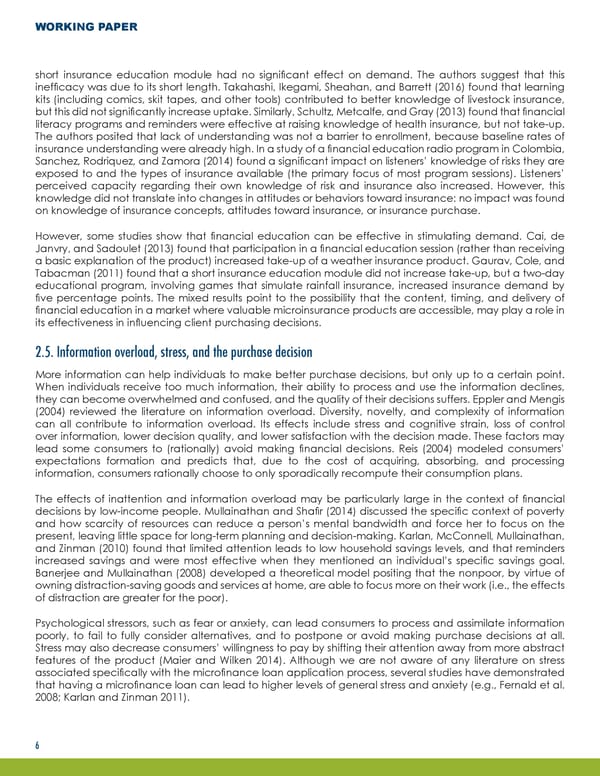WORKING PAPER short insurance education module had no significant effect on demand. The authors suggest that this inefficacy was due to its short length. Takahashi, Ikegami, Sheahan, and Barrett (2016) found that learning kits (including comics, skit tapes, and other tools) contributed to better knowledge of livestock insurance, but this did not significantly increase uptake. Similarly, Schultz, Metcalfe, and Gray (2013) found that financial literacy programs and reminders were effective at raising knowledge of health insurance, but not take-up. The authors posited that lack of understanding was not a barrier to enrollment, because baseline rates of insurance understanding were already high. In a study of a financial education radio program in Colombia, Sanchez, Rodriquez, and Zamora (2014) found a significant impact on listeners’ knowledge of risks they are exposed to and the types of insurance available (the primary focus of most program sessions). Listeners’ perceived capacity regarding their own knowledge of risk and insurance also increased. However, this knowledge did not translate into changes in attitudes or behaviors toward insurance: no impact was found on knowledge of insurance concepts, attitudes toward insurance, or insurance purchase. However, some studies show that financial education can be effective in stimulating demand. Cai, de (2013) found that participation in a financial education session (rather than receiving Janvry, and Sadoulet a basic explanation of the product) increased take-up of a weather insurance product. Gaurav, Cole, and Tabacman (2011) found that a short insurance education module did not increase take-up, but a two-day educational program, involving games that simulate rainfall insurance, increased insurance demand by five percentage points. The mixed results point to the possibility that the content, timing, and delivery of financial education in a market where valuable microinsurance products are accessible, may play a role in its effectiveness in influencing client purchasing decisions. 2.5. Information overload, stress, and the purchase decision More information can help individuals to make better purchase decisions, but only up to a certain point. When individuals receive too much information, their ability to process and use the information declines, they can become overwhelmed and confused, and the quality of their decisions suffers. Eppler and Mengis (2004) reviewed the literature on information overload. Diversity, novelty, and complexity of information can all contribute to information overload. Its effects include stress and cognitive strain, loss of control over information, lower decision quality, and lower satisfaction with the decision made. These factors may lead some consumers to (rationally) avoid making financial decisions. Reis (2004) modeled consumers’ expectations formation and predicts that, due to the cost of acquiring, absorbing, and processing information, consumers rationally choose to only sporadically recompute their consumption plans. information overload may be particularly large in the context of financial The effects of inattention and decisions by low-income people. Mullainathan and Shafir (2014) discussed the specific context of poverty and how scarcity of resources can reduce a person’s mental bandwidth and force her to focus on the present, leaving little space for long-term planning and decision-making. Karlan, McConnell, Mullainathan, and Zinman (2010) found that limited attention leads to low household savings levels, and that reminders increased savings and were most effective when they mentioned an individual’s specific savings goal. Banerjee and Mullainathan (2008) developed a theoretical model positing that the nonpoor, by virtue of owning distraction-saving goods and services at home, are able to focus more on their work (i.e., the effects of distraction are greater for the poor). Psychological stressors, such as fear or anxiety, can lead consumers to process and assimilate information poorly, to fail to fully consider alternatives, and to postpone or avoid making purchase decisions at all. Stress may also decrease consumers’ willingness to pay by shifting their attention away from more abstract features of the product (Maier and Wilken 2014). Although we are not aware of any literature on stress associated specifically with the microfinance loan application process, several studies have demonstrated that having a microfinance loan can lead to higher levels of general stress and anxiety (e.g., Fernald et al. 2008; Karlan and Zinman 2011). 6
 Responsible Bundling of Microfinance Services Page 8 Page 10
Responsible Bundling of Microfinance Services Page 8 Page 10